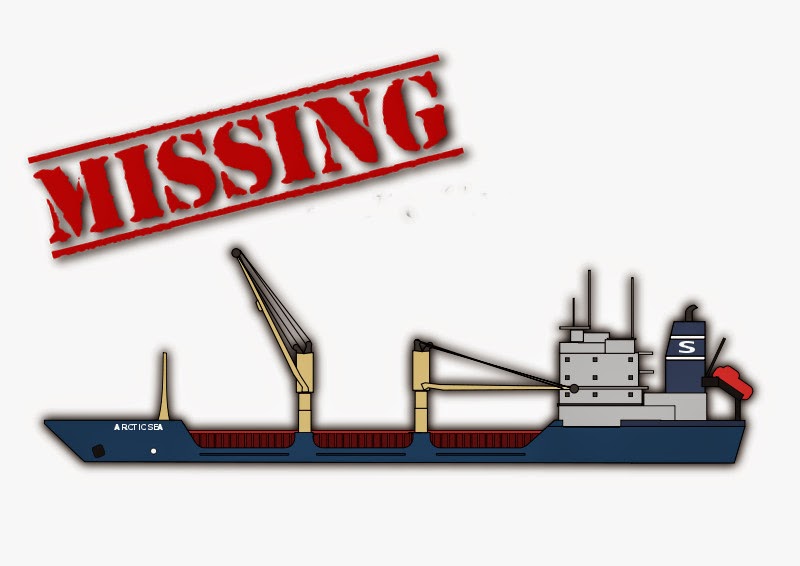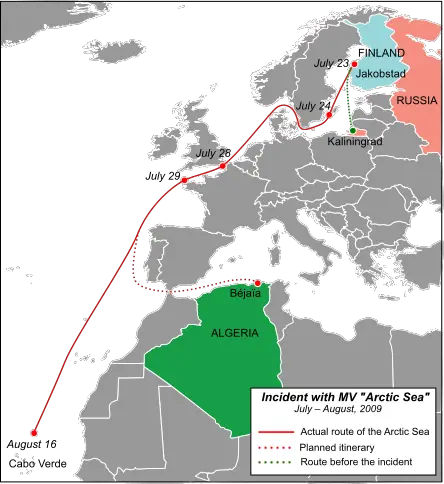It was a story similar to the mysterious disappearance of Malaysia Airlines Flight 370 out of Kuala Lampur on March 8, 2014, in that a huge piece of modern machinery vanished without explanation. But this modern day mystery took place at sea.
The big difference between the two events is that this mystery was eventually partially solved, unlike the Malaysia Airlines airplane that still has not been found. In this case, how did a modern ship, with all the technological advantages we have today, disappear in modern times? And the bigger question might be, why?
A merchant cargo ship, the MV Arctic Sea, registered in Malta, was en route from Finland to Algeria in 2009 reportedly carrying a supply of timber worth $1.8 million. This was about the only piece of information that wasn’t confusing. Beyond these facts, the entire journey of the MV Arctic Sea and what happened aboard are rather sketchy.
On July 24th of 2009, the ship, operated by a Russian crew, was allegedly boarded by hijackers, or pirates if you like that term better. For some reason, this intrusion off the coast of Sweden wasn’t reported right away and contact with the ship ceased around the 30th of July.
The story begins when a group of eight to ten men reportedly boarded the boat on July 24th, wearing clothing with the Swedish word for police, Polis, emblazoned on them. The ship’s captain reported to the owner that the men searched the ship and then left. The captain also reported that some of the crew had been injured. But the Swedish government denied that any of its personnel had boarded the ship.
On July 28, the British made contact with the ship as it went through the Strait of Dover. It was its last radio contact. It was believed that the hijackers made sure that the crew didn’t signal an alarm at that time.
The ship’s Automatic Identification System (AIS) continued to signal until July 30. The AIS is analogous to an airplane’s transponder. It gives the ship’s position, direction, and speed, just as a transponder in an aircraft gives its airspeed, altitude, and position. The ship’s AIS stopped after that date, making the MV Arctic Sea officially disappear.
The ship never arrived to the port of Béjaïa in Algeria, its intended port of call, on its scheduled date of August 5th. It was picked up temporarily off the French coast and seen later by a patrol aircraft off the coast of Portugal. It wasn’t until the Spanish didn’t report its passage through the Strait of Gibraltar that an alarm was sent out by INTERPOL for a hijacking on August 3rd. The Russian Navy sent ships to aid in the search, and Portugal did the same.
The MV Arctic Sea vanished into thin air for eleven days. The 320 foot vessel, a little longer than a football field, was nowhere to be seen. It wasn’t like it was a fast ship either, having a cruising speed of about 12.5 knots, or about 14 mph, using its one diesel engine.
It was finally sighted off Cape Verde near the coast of west Africa on August 14th. A Russian frigate supposedly spotted the vessel. I say supposedly because it wasn’t until August 17th, three days later, that the Defense Minister of Russia announced that the ship had been seized. The crew of fifteen aboard the ship were said to be in good shape. But for some reason, the Russians waited to keep the location and their plans for the Arctic Sea secret.
Things didn’t become any clearer after the Arctic Sea was found. The Finnish Police claimed there had been a ransom demand, but the ship’s owners stated they hadn’t received such a demand. This claim was backed by the security chief of the Renaissance Insurance Group, a Russian insurance agency. He said they had been told the hijackers wanted 1.5 million Euros, and if the demand wasn’t met, they would kill the crew and sink the ship.
By August 18, things got even murkier. The Russians reported that eight hijackers had been arrested; four Estonians, two Latvians, and two Russians. Two days later the Estonian Security Police said six of the eight were Estonian residents. Of these, one had citizenship for Estonia, two had Russian citizenship, and three were undefined.
The Russians stated that the hijackers made it aboard the ship by claiming they had engine trouble on their boat. The alleged hijackers denied they attempted a hijacking, saying their boat ran out of fuel, and they were ecologists working for an unnamed organization. The alleged hijackers contended that the atmosphere on the boat wasn’t that of a hostage situation but a sort of pleasure cruise, and the crew of the MV Artic Sea rescued them and welcomed them aboard.
All of the hijackers were found guilty in one form or another in a Russian court, with one man, a Latvian businessman who wasn’t part of the boarding party, being also found guilty. But the speculation on what really went down on the Arctic Sea and why remained a mystery.
The MV Arctic Sea was owned by a Finnish company and was operated by a company based out of Cyprus with offices in Russia. Other than that, the Russian crew was the most Russian thing about the ship. So why were the Russians so involved in the aftermath of this incident?
Under the United Nations Convention of the Law of the Sea, people charged in the crime of piracy while in international waters are tried under the laws of the country that arrests them. Russia found the ship, so they had the right to prosecute the ones breaking the law. But why was Russia so intent on finding this ship? That was the big question, and the one that opened up a slew of conspiracy theories that didn’t sound that far fetched.
Why would a group decide to hijack a ship carrying only timber, and do it in the North Sea where a hijacking hadn’t occurred in centuries? Why did the Russians show such a strong response by sending multiple ships to find the Arctic Sea? And what with the secrecy? Why did the Russians take such a long time between when they found the ship to when they announced it had been seized? It wasn’t until October 29, 2009 that the Russian Navy delivered the ship back to the owners in Malta. There was even a gag order on the Russian crew not to speak of the incident with the threat of prosecution if they did.
Many have tried to come up with answers to these questions since there have been no real explanations about the ship’s disappearance. This has caused the theories to swirl about Russia’s strange behavior during and after seizing the ship. Unfortunately, without any hard evidence, everything that has been proposed is pure speculation.
One such explanation was the possible presence of Russian cruise missiles aboard the ship. There was nothing to back this up, but why did the Russians deploy a large naval force to try and find the ship? This theory rests on a belief that the hijackers were hired by the Mossad, the Israeli intelligence service, to stop the supposed cargo of missiles from reaching their intended destination in Iran.
Another theory had the Russian government instigating the hijacking when it found out that Russian organized crime was attempting to deliver cruise missiles to Iran, but this is a shaky conspiracy theory at best. Nuclear weapons possibly? No, said Finnish authorities, stating that radiation tests had been conducted on the ship while it was in port in Finland and nothing had been found. How about Mig-31 hulls to Syria? Russia suspended that shipment in 2009, but they said they still planned to deliver them.
The three mysterious days after the seizure of the ship brought even more speculation. A pair of Russian transport planes had been flown to Cape Verde to take the crew and the hijackers back to Russia. What if the aircraft was loaded with something else along with the passengers? Maybe it was the alleged illicit missile cargo aboard the ship that was supposedly carrying only timber. Another conspiracy theory that can’t be proved. And where was the ship going as it continued down the African coast? Yet another question that had no answer.
With the gag order on the crew, and with the hijackers in a Russian prison, we may never know the true nature of the Arctic Sea’s disappearance or the reasons why the hijackers decided to illegally board a ship in the North Sea.
It continues to be amazing that a huge, slow ship could vanish in the modern era, however, even with our many technologically advanced tracking methods. But the Arctic Sea still managed to disappear, and the mystery will only continue on what was, or wasn’t, really aboard that merchant cargo ship.
Sources: The Guardian, Wikipedia, The Telegraph, Spiegel



